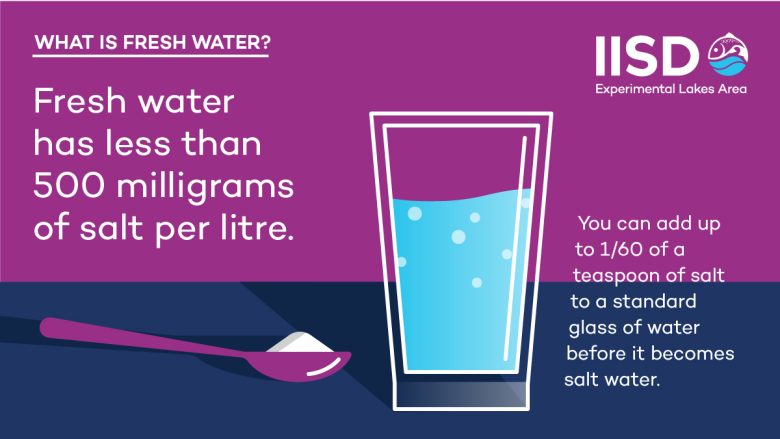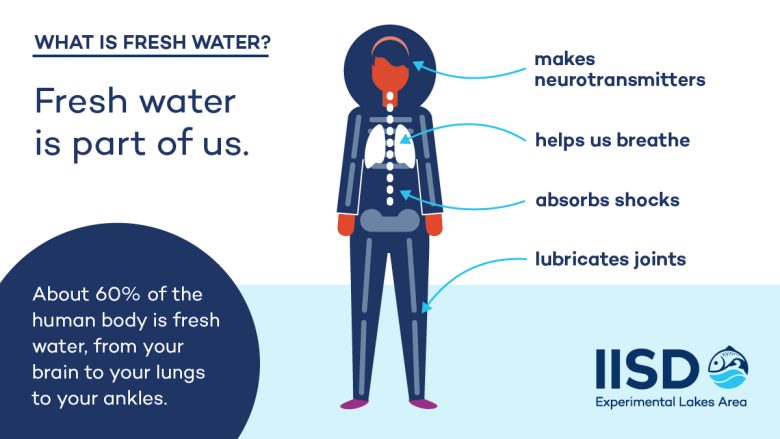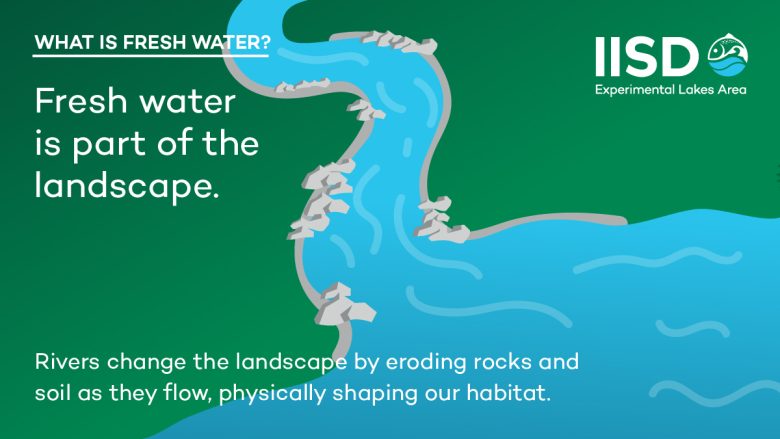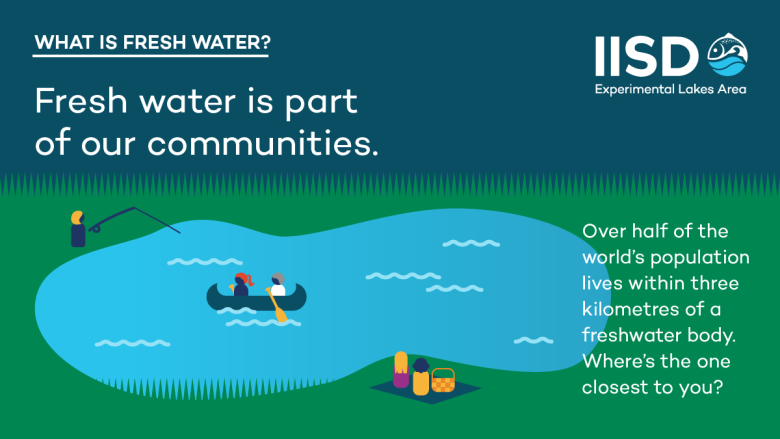Fresh water takes many forms, including clouds, rivers, icebergs, most lakes, and the water in your glass. Because of this wide range, it’s often defined as what it’s not: salty.
Fresh water has less than 500 milligrams of salt per litre, or 500 parts per million (ppm) of salt, according to Environment Canada. This is equivalent to 0.05%. The United States Geological Survey uses a slightly different definition: less than 1,000 ppm, or 0.10%. Across organizations, it’s almost always defined as less than 1% salt and often—as in these two examples—well below that.

Seems Pretty Simple
This western scientific approach does give a very straightforward answer, but what about other perspectives? At IISD Experimental Lakes Area, we work on Treaty #3 territory, the traditional land of the Anishinaabe Nation and the homeland of the Métis Nation. In 2019, the Nibi Declaration of Treaty #3 formally recognized Anishinaabe nibi inakonigaawin, which translates to Anishinaabe water law. This declaration recognizes nibi (water) as alive and as having its own spirit. Nibi is seen as a relative and a teacher. It has relationships with other living beings, and these relationships carry responsibilities – just like our relationships with human relatives and friends.
As you read this, water is keeping your body oxygenated and at a comfortable temperature, digesting food, and protecting your joints, brain, and spinal cord.
All Anishinaabe are responsible for taking care of nibi. Women have the specific role of speaking for it, because—like nibi—they are capable of giving life. While Anishinaabe take care of and give offerings to nibi, nibi provides physical, emotional, mental, and spiritual well-being and healing. Nibi is sacred, nibi is medicine, and nibi is alive.
So Why Do We Need Fresh Water?
All organisms need water to survive. Most species use either fresh or saltwater, and have specific adaptations to the kind of water that they need. For example, freshwater fish actively transport salt into their bodies and water out of their bodies to maintain the proper internal salt concentration. The opposite process happens in marine fish. Despite covering only 0.8% of Earth’s surface, freshwater ecosystems support over 40% of fish species and 2% of all invertebrate species.
Back on land, humans need to consume fresh water for cellular processes and use it for hygiene to stay healthy—which has been particularly emphasized by COVID-19. We’re also mostly fresh water ourselves. As you read this, water is keeping your body oxygenated and at a comfortable temperature, digesting food, and protecting your joints, brain, and spinal cord. It’s even helping you process this information by playing a role in making neurotransmitters. From the most fundamental biochemical reactions to large-scale habitat, fresh water is needed for every aspect of life.

We Don’t Live in Fresh Water, but It Still Shapes Our Habitat…
Fresh water literally shapes our world. As it runs over rocks and soil, it carves its paths into the landscape. Rain falling near, say, Woodland Caribou Provincial Park, about three hours north of IISD Experimental Lakes Area, may land in a headwater lake emptying into a river that ultimately leads to Lake Winnipeg.
On its way, it could be swept into wetlands, tributaries, and pools alongside the river, becoming part of different habitats and connecting people within and across territories. The running water accumulates sediments, nutrients, and salts as it erodes the land, and it’s this process that contributes most of the salt that ends up in oceans.
Fresh water literally shapes our world. As it runs over rocks and soil, it carves its paths into the landscape.
From Lake Winnipeg, water empties into Hudson Bay and the Arctic and Atlantic Oceans. When it evaporates from oceans, the salt stays, turning the vapour into fresh water once again.

… and it shapes everything else about our homes too.
Lakes and rivers are often cornerstones of communities. Right now, like more than half of the world’s population, you’re probably within 3 kilometres of a freshwater body, and you’re almost definitely within 10 kilometres of one. Living close to fresh water has been important for cleaning, farming, and accessing drinking water throughout human history.
Even though many urban areas now rely on pipes that carry water long distances, people continue to live nearby for cultural and aesthetic reasons. Think about the freshwater body closest to you—what role does it play in your life? I’m writing from near the Assiniboine River: for my community, its shores are a gathering place, the water itself is a boating or skating route, and its fish are a source of food.

The basic scientific definition—less than 500 ppm of salt—is useful for classification, but it doesn’t include the complexities of fresh water’s role in physical and cultural landscapes. Fresh water affects everything in our lives, from how our bodies are built to where we live to how we spend our time. It provides for us, and in return, we all have a part in taking care of it for generations to come.
Want to get back to some more basics? Be sure to check out our blog posts What Is a Lake? and What Is a Limnologist?
You know that ground-breaking freshwater research you just read about? Well, that’s actually down to you.
It’s only thanks to our generous donors that the world’s freshwater laboratory—an independent not-for-profit—can continue to do what we do. And that means everything from exploring what happens when cannabis flushes and oil spills into a lake, to how we can reduce mercury in fish and algal blooms in fresh water—all to keep our water clean around the world for generations to come.
We know that these are difficult times, but the knowledge to act on scientific evidence has never been more important. Neither has your support.
If you believe in whole ecosystem science and using it to bring about real change to fresh water around the globe, please support us in any way you are able to.